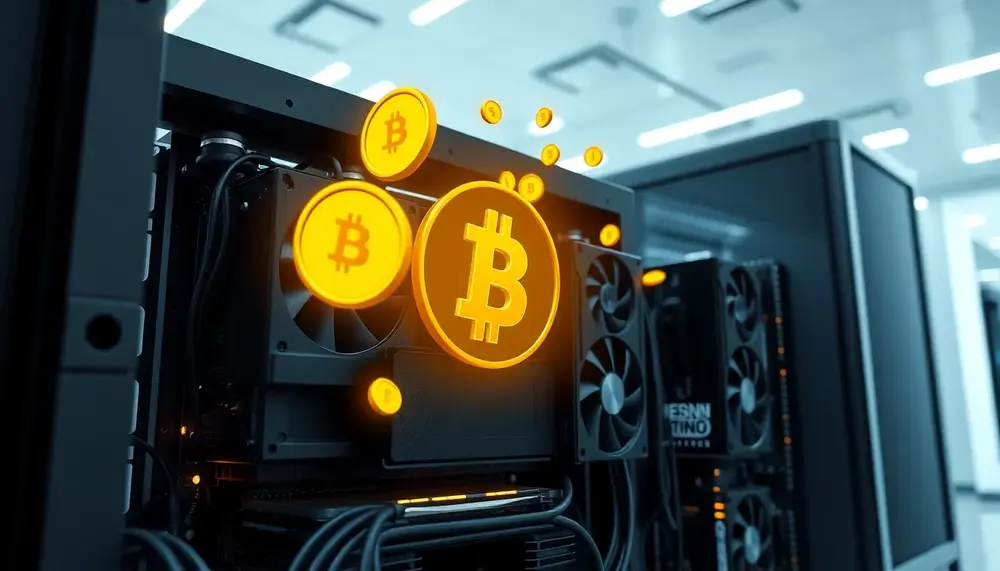Table of Contents:
Monero (XMR) 2025: Privacy, Technology, and Market Outlook
Monero (XMR) has established itself as a benchmark for privacy in the cryptocurrency world since its launch in 2014. Unlike Bitcoin or Ethereum, which operate on transparent blockchains, Monero uses an opaque blockchain that fully conceals the identities of senders and recipients as well as transaction amounts. The main goal of Monero is to be a fully fungible cryptocurrency, ensuring that each XMR unit is indistinguishable from another, thus preventing discrimination based on transaction history. This makes Monero a unique advocate for financial privacy in the crypto ecosystem, as it is impossible to identify the sender, recipient, or the amounts involved in any transaction.
Monero’s development began in April 2014 under the name BitMonero, a combination of “Bit” (referring to Bitcoin) and “Monero” (meaning “coin” in Esperanto). The community soon shortened the name to Monero. It was originally a fork of Bytecoin, but due to concerns over Bytecoin’s pre-mined supply, Monero was created as a fairer alternative. Key contributors include Ricardo “fluffypony” Spagni, Francisco “ArticMine” Cabañas, and Luigi1111. Notably, Monero had no premining or initial token sale, ensuring fair distribution and alignment of interests between developers and the community.
- Monero is designed for complete privacy and fungibility.
- It is impossible to trace transactions or identify users.
- There was no premining or initial token sale.
Summary: Monero stands out for its privacy, fungibility, and fair distribution, with a strong community and decentralized development. (Source: investx.fr)
Get $500 free Bitcoin mining for a free testing phase:
- Real daily rewards
- 1 full month of testing
- No strings attached
If you choose to buy after testing, you can keep your mining rewards and receive up to 20% bonus on top.
Monero’s Use Cases and Network Functionality
Monero serves several essential functions that distinguish it from other cryptocurrencies. It acts as a private and confidential medium of exchange, allowing users to transact without revealing their identity, transaction amount, or fund history. This is particularly valuable for individuals under authoritarian regimes, businesses protecting sensitive information, or anyone concerned about privacy. Monero also functions as a censorship-resistant store of value, protecting users from financial censorship that can affect fiat currencies or even transparent cryptocurrencies like Bitcoin. Its perfect fungibility ensures that no XMR can be rejected based on its usage history.
The Monero network operates on a Proof of Work (PoW) consensus model using the RandomX algorithm, which is ASIC-resistant and allows ordinary users to mine with standard CPUs. Each block is generated approximately every two minutes, faster than Bitcoin’s ten-minute interval. Monero’s emission policy includes an initial supply of 18.4 million XMR, followed by a continuous emission of 0.6 XMR per block indefinitely, providing ongoing incentives for miners.
| Feature | Details |
|---|---|
| Consensus | Proof of Work (RandomX, ASIC-resistant) |
| Block Time | ~2 minutes |
| Initial Emission | 18.4 million XMR |
| Tail Emission | 0.6 XMR per block (unlimited) |
Summary: Monero’s network is designed for privacy, decentralization, and ongoing miner incentives, with a unique emission policy and ASIC-resistant mining. (Source: investx.fr)
Privacy Technologies and Security
Monero’s privacy is based on three main cryptographic technologies:
- Ring Signatures: Hide the sender’s identity by mixing their signature with others, making it impossible to determine the actual sender.
- Stealth Addresses: Generate a unique one-time address for each transaction, concealing the recipient’s identity and transaction history.
- RingCT (Ring Confidential Transactions): Conceals transaction amounts, ensuring full confidentiality.
In 2018, Monero implemented Bulletproofs, reducing transaction size by about 80% and lowering fees, thus improving scalability. These technologies ensure that transactions are verifiable and valid while remaining fully private.
Summary: Monero’s privacy is enforced by default through advanced cryptography, making all transactions confidential and untraceable. (Source: investx.fr)
Advantages and Disadvantages of Monero
- Advantages:
- Unmatched privacy: Anonymity is mandatory for all transactions.
- Perfect fungibility: No XMR can be rejected based on its history.
- Censorship resistance: The network is designed to resist control and censorship.
- Improved scalability: Bulletproofs have reduced transaction size and fees.
- Active community: Monero benefits from passionate developers and users.
- Disadvantages:
- Regulatory challenges: Some exchanges have delisted Monero due to AML/KYC requirements.
- Technical complexity: Privacy features require significant computing resources.
- Limited merchant adoption: Fewer merchants accept Monero compared to Bitcoin or Ethereum.
- Reputation risk: Its privacy features make it attractive for illicit activities, drawing regulatory scrutiny.
- Price volatility: Like most cryptocurrencies, Monero’s price can be highly volatile.
Summary: Monero offers strong privacy and decentralization but faces regulatory and adoption challenges. (Source: investx.fr)
Monero Price History and Forecasts
Monero’s price has experienced significant fluctuations. At launch in 2014, it traded for less than $1. The first major surge occurred in 2016 when darknet markets began accepting XMR, recognizing its privacy features. The 2017-2018 bull run saw Monero reach a historic high of about $495 in January 2018. After a correction, Monero surged again during the 2020-2021 bull run, reaching a new all-time high of about $517 in May 2021.
In 2025, Monero’s price saw renewed growth. At the start of the year, XMR traded at around $180, rising to $344.42 in May 2025—an increase of more than 112% since the beginning of the year. This growth is attributed to rising interest in privacy-oriented cryptocurrencies amid increasing financial surveillance.
| Date | Price (USD) |
|---|---|
| 2014 (Launch) | < $1 |
| Jan 2018 | ~$495 |
| May 2021 | ~$517 |
| Jan 2025 | ~$180 |
| May 2025 | $344.42 |
Forecasts for 2025 vary:
- Investing.com: Bullish scenario up to $548.24 in 2025.
- Kraken: If Monero maintains a 5% growth rate, price could reach $645.25 by end of 2025.
- CoinCodex: Short-term forecast of $378.44 by June 2025.
- Long-term projections for 2030 suggest potential prices between $1,000 and $2,000, depending on regulatory developments and adoption.
Summary: Monero’s price has more than doubled in 2025, with forecasts ranging from $378.44 to $645.25 for the year and up to $2,000 by 2030. (Source: investx.fr)
Key Milestones in Monero’s History
- April 2014: Monero launched as a fork of Bytecoin.
- September 2014: Monero suffered an attack exploiting a CryptoNote protocol vulnerability, which was quickly resolved.
- January 2017: Implementation of RingCT to hide transaction amounts.
- September 2017: Hard fork to increase minimum ring size to 5, enhancing privacy.
- April 2018: Hard fork to change PoW algorithm, countering ASIC mining dominance.
- October 2018: Implementation of Bulletproofs, reducing transaction size by about 80%.
- November 2019: Launch of RandomX, optimized for CPUs, making mining more accessible.
- May 2021: XMR reached an all-time high of $517 after a 153% increase in six weeks.
- February 2024: Major network update with Seraphis, improving privacy and efficiency.
- May 2025: XMR price reached $412 amid growing interest in financial privacy.
Summary: Monero’s history is marked by continuous technical improvements and a strong commitment to privacy and decentralization. (Source: investx.fr)
How to Buy and Store Monero (XMR)
XMR tokens are available on several centralized exchanges (CEX), allowing purchases with euros or dollars via various payment methods. The best platforms in 2025 offer low trading fees (0.02% to 0.06%), futures trading, and varying KYC requirements. It is recommended to use crypto-specialized platforms for direct ownership and control of assets.
- Create an account on a platform like Bitget.
- Complete KYC verification.
- Deposit funds via bank transfer, credit card, or crypto.
- Buy XMR through spot trading (XMR/USDT or XMR/EUR pairs).
- Transfer XMR to a personal wallet for security.
For storage, users can choose between:
- Cold Wallets (Hardware): Devices like Ledger Nano S Plus or Ledger Nano X, offering the highest security for large or long-term holdings.
- Hot Wallets (Software): Apps or browser extensions like MetaMask or Trust Wallet, suitable for frequent use but more vulnerable to online threats.
Summary: Buy XMR on reputable exchanges and store it in a secure wallet, preferably a hardware wallet for large amounts. (Source: investx.fr)
Legal Status and Distribution of Monero
The legality of Monero varies by jurisdiction. In most Western countries, owning and using XMR is legal but subject to tax obligations and sometimes restricted on exchanges due to AML/KYC regulations. In the US, XMR is not illegal, but some platforms do not offer it due to compliance difficulties. The IRS has offered rewards for tools to trace XMR transactions. In the EU, XMR is generally legal but subject to the 5th Anti-Money Laundering Directive (AMLD5). Countries like Japan, South Korea, and Australia have taken stricter stances, with local platforms delisting XMR.
Due to Monero’s privacy features, it is nearly impossible to determine who holds the most XMR. Miners, especially large pools like MineXMR, SupportXMR, and NanoPool, likely control significant amounts. Early participants and developers may also hold substantial XMR, but there was no premining or initial token sale. Institutional investors and crypto funds are attracted to Monero’s privacy, but holdings are not publicly disclosed.
Summary: Monero’s legal status depends on local regulations, and its distribution is opaque due to its privacy features. (Source: investx.fr)
Expert Opinion and Outlook for 2025
In 2025, Monero continues to solidify its position as the leading privacy-focused cryptocurrency, despite increasing regulatory complexity. Technical advancements like Seraphis and Triptych have enhanced privacy and performance. The passionate developer community and loyal user base position XMR as a sustainable solution for those valuing financial privacy. While regulatory challenges persist, Monero’s decentralized and censorship-resistant nature allows it to thrive. As debates over surveillance and privacy intensify, XMR plays a crucial role in preserving the right to confidentiality.
Summary: Monero remains the reference for privacy in crypto, with ongoing technical progress and a strong community, despite regulatory headwinds. (Source: investx.fr)
Sources:
















